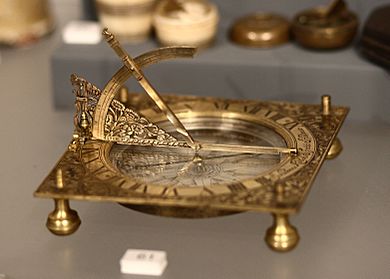Harvard Collection of Historical Scientific Instruments facts for kids

A universal compass sundial from Stockholm c. 1650 – 1679, on display in the Putnam Gallery
|
|
| Lua error in Module:Location_map at line 420: attempt to index field 'wikibase' (a nil value). | |
| Accreditation | AAM |
|---|---|
| Collection size | 20,000 |
| Owner | Harvard University |
| Public transit access | Harvard (MBTA Red Line) |
The Collection of Historical Scientific Instruments (CHSI) at Harvard University is a very special place. It was started in 1948. This collection is known as one of the three largest of its kind in the world. It holds about 20,000 amazing objects. You can explore many of these items online through their catalog called Waywiser. The collection began when Mr. David P. Wheatland started keeping old equipment. He wanted to save these items from being taken apart for their pieces.
Contents
Exploring the Collection
The CHSI has many cool things to see. Some of these instruments are part of a permanent exhibit. This exhibit is called Time, Life, & Matter: Science in Cambridge. You can find it in the Putnam Gallery. This gallery is on the first floor of the Harvard Science Center. It is free to visit and open most days.
Special Exhibits and Galleries
Besides the main exhibit, there are other displays. The Special Exhibitions Gallery is on the second floor. It shows different collections that change over time. There is also a smaller Foyer Gallery. This one is located on the third floor.
The Science Center building was made bigger in 2004. A new four-story section was added. This new part has offices and classrooms. It also has more public spaces for the CHSI. The Department of the History of Science is also located here.
What's in the Collection?
The CHSI has many old and important scientific tools. Some of these were bought around 1765. They replaced equipment lost in a big fire at Harvard Hall. That fire also destroyed the university's library.
Historic Instruments
These older items include tools for electricity experiments. They also show how physics was understood long ago. This was back in the late 1700s.
Other cool things in the collection include many sundials. This is one of the biggest private collections of sundials in North America. You can also see a special compass. It was designed by the famous scientist Galileo Galilei. Another interesting item is the control console. It came from the old Harvard Cyclotron Laboratory.
The Harvard Mark I Computer
One of the biggest items in the collection is the Harvard Mark I. This was a huge electromechanical computer. It was built in 1944. It used to be displayed in the main lobby of the Science Center. Now, it is at the Harvard John A. Paulson School of Engineering and Applied Sciences.
How the Collection is Managed
The CHSI continues to grow. It is guided by Curator Sara J. Schechner. The collection used to be part of the Harvard Library. Now, it is part of Harvard's Department of the History of Science. It is also one of the four Harvard Museums of Science and Culture.
The CHSI is connected to the American Alliance of Museums. There are plans to make the collection even better. These plans include more ways to preserve items. They also focus on education, research, and public displays. This means more learning opportunities for everyone.

